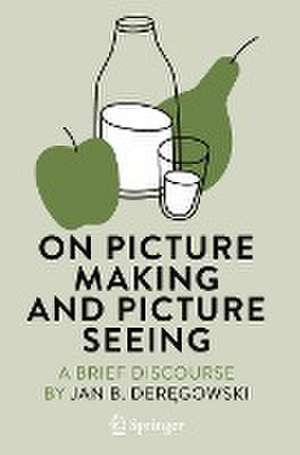On Picture Making and Picture Seeing: A Brief Discourse: Vision, Illusion and Perception, cartea 4
Autor Jan B. Deręgowskien Limba Engleză Hardback – 4 apr 2023
The visual process is universally uniform (if it were not, one would not be able to recognise an Altamira bison as a bison) and its foibles can be freely exploited.
Its best known exploiter is probably Cezanne. His pictures are admired by many and puzzle many. Strzemiński postulated that they compound distinct lines of sight, thus endorsing primacy of central vision, a concept thought by Gombrich to be of greater import to geometers than to artists.
Preț: 280.10 lei
Nou
Puncte Express: 420
Preț estimativ în valută:
53.61€ • 58.26$ • 45.06£
53.61€ • 58.26$ • 45.06£
Carte tipărită la comandă
Livrare economică 18-24 aprilie
Preluare comenzi: 021 569.72.76
Specificații
ISBN-13: 9783031233470
ISBN-10: 3031233476
Pagini: 109
Ilustrații: IX, 109 p. 93 illus., 39 illus. in color.
Dimensiuni: 155 x 235 mm
Greutate: 0.39 kg
Ediția:2023
Editura: Springer International Publishing
Colecția Springer
Seria Vision, Illusion and Perception
Locul publicării:Cham, Switzerland
ISBN-10: 3031233476
Pagini: 109
Ilustrații: IX, 109 p. 93 illus., 39 illus. in color.
Dimensiuni: 155 x 235 mm
Greutate: 0.39 kg
Ediția:2023
Editura: Springer International Publishing
Colecția Springer
Seria Vision, Illusion and Perception
Locul publicării:Cham, Switzerland
Cuprins
Introduction in which the reader enters pictorial donnybrook.- On perception of depth, real and portrayed.- On perspective in many guises.- On prof. Farish's immediately comprehensible and Cezanne's immediately puzzling pictures.- On cultural press; If we draw, what and how should we draw?.
Notă biografică
Jan B. Deręgowski, D.Sc., FRSE, FBPsS, is Professor Emeritus of Psychology at the University of Aberdeen. He has been pursuing studies of visual perception in many cultures and has published some of his findings in Illusions, Patterns and Pictures (Academic Press, 1980) as well as, recently, two overviews: Cross-cultural Studies of Illusions (in the Oxford compendium of Visual Illusions, OUP, 2017) and The Psychology of Graphic Perception (in the Oxford Handbook of Archaeology and Anthropology of Rock Art, OUP, 2018).
Textul de pe ultima copertă
Archaeological and anthropological investigations of depictions seldom extend beyond a single culture or a single geographical location, although there is a powerful factor common to all depictions, the factor of human perception. In this volume an attempt is made to show how this factor affects both creation and recognition of depictions, how, in common with everyday vision of the environment, typical contours are derived and used, not merely to depict individually readily recognisable models, but also how by concatenation they lead to such a splendid figure as Australian Kakadu crocodiles, or by distortion to creation of illusions of pictorial depth, such as is evoked by Leonardo da Vinci’s perspective and by inverted (Byzantine) perspective thought by some to be an aberration. Bartel’s studies show that pictorial depth is often achieved to the artist’s, and many a viewer’s, but not to geometer’s satisfaction by partial distortion, and Chinese masterpieces embody, side by side, ‘normal’ and inverted perspective.
The visual process is universally uniform (if it were not, one would not be able to recognise an Altamira bison as a bison) and its foibles can be freely exploited.
Its best known exploiter is probably Cezanne. His pictures are admired by many and puzzle many. Strzemiński postulated that they compound distinct lines of sight, thus endorsing primacy of central vision, a concept thought by Gombrich to be of greater import to geometers than to artists.
The visual process is universally uniform (if it were not, one would not be able to recognise an Altamira bison as a bison) and its foibles can be freely exploited.
Its best known exploiter is probably Cezanne. His pictures are admired by many and puzzle many. Strzemiński postulated that they compound distinct lines of sight, thus endorsing primacy of central vision, a concept thought by Gombrich to be of greater import to geometers than to artists.
Caracteristici
Fantastic colourful book on Picture Making and Picture Seeing Offers an interesting perspective on the development of styles and conventions in art and how these link to perception Presents a nice read packed with lovely illustrations




